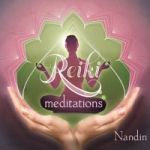 People are drawn to music for a wide variety of reasons and purposes. For flutist and multi-instrumentalist Nandin, music is a vehicle for spiritual attunement and healing… although it wasn’t always like that for her. In her earlier years Nandin (rhymes with Kathleen) studied with famous flutists, practicing for hours daily, getting a music degree in composition, winning competitions, playing in a professional orchestra and various ensembles and finally teaching at the local University and Music College in her native Canada. While she first studied piano and guitar, when she was 16, hearing the sound of a flute was like the call of the Pied Piper to Nandin and she was entranced by it. In her words: “I heard someone playing the flute, and suddenly I had to have one. I mean, I really had to have one! I saved up by working at the local summer fair in Calgary.”
People are drawn to music for a wide variety of reasons and purposes. For flutist and multi-instrumentalist Nandin, music is a vehicle for spiritual attunement and healing… although it wasn’t always like that for her. In her earlier years Nandin (rhymes with Kathleen) studied with famous flutists, practicing for hours daily, getting a music degree in composition, winning competitions, playing in a professional orchestra and various ensembles and finally teaching at the local University and Music College in her native Canada. While she first studied piano and guitar, when she was 16, hearing the sound of a flute was like the call of the Pied Piper to Nandin and she was entranced by it. In her words: “I heard someone playing the flute, and suddenly I had to have one. I mean, I really had to have one! I saved up by working at the local summer fair in Calgary.”
About the same time Nandin started playing flute she also began doing yoga, which opened her up to a sense of 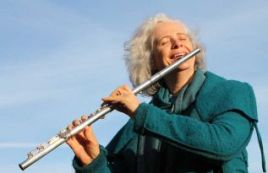 inner peace and spirituality. At a point along her path, Nandin felt a strong calling to the spiritual teacher Osho, which led her in new and unexpected directions. As she describes: “When I first played for Osho in India, he gave me one of his penetrating looks, and for me, time stopped. I was filled to the brim with presence and tears came afterwards as an overflow in a kind of peaceful joyousness.“ She became drawn to playing meditative music for its calming effect on listeners, as well as on herself.
inner peace and spirituality. At a point along her path, Nandin felt a strong calling to the spiritual teacher Osho, which led her in new and unexpected directions. As she describes: “When I first played for Osho in India, he gave me one of his penetrating looks, and for me, time stopped. I was filled to the brim with presence and tears came afterwards as an overflow in a kind of peaceful joyousness.“ She became drawn to playing meditative music for its calming effect on listeners, as well as on herself.
Also after years of formal musical training Nandin began to discover joy of improvising and being in the moment with the music. In her words: “Once I got away from classical music, Hari Prasad Chaurasia became for me an icon since he is the absolute master of the Indian bamboo bansuri flute. Indian music is mostly based on improvisation, which also appealed to me. I was always attracted to improvising, but only got good at it after my classical training gave me really good technique to rely on. Now I can simply let go and play.”
 Building on the calming effect of meditative music, Nandin began to study various forms of healing as well. In this regard she shares: “I have studied many healing techniques – including Reiki, Prana Healing, Divine Healing, Shiatsu, Cranio-sacral healing, Rebalancing, Intuitive Massage, Attunement, Essence Healing, and the Enneagram. I have personally felt the release of energy and emotions of the people that I was working with. In many of these techniques, we work with intention, and I would say that similarly, the intention behind the music also carries over to the listener.” The particular healing modality this album is based on is Reiki, which Nandin describes in this way: “Reiki is a Japanese form of what we call in the West “the laying on of hands”, which has been around unofficially for centuries. (Even some doctors are said to depend on their “bedside manner,” with regard to the healing process of their patients.) Basically, we are energy receivers and transmitters, and Reiki is one way to access this.”
Building on the calming effect of meditative music, Nandin began to study various forms of healing as well. In this regard she shares: “I have studied many healing techniques – including Reiki, Prana Healing, Divine Healing, Shiatsu, Cranio-sacral healing, Rebalancing, Intuitive Massage, Attunement, Essence Healing, and the Enneagram. I have personally felt the release of energy and emotions of the people that I was working with. In many of these techniques, we work with intention, and I would say that similarly, the intention behind the music also carries over to the listener.” The particular healing modality this album is based on is Reiki, which Nandin describes in this way: “Reiki is a Japanese form of what we call in the West “the laying on of hands”, which has been around unofficially for centuries. (Even some doctors are said to depend on their “bedside manner,” with regard to the healing process of their patients.) Basically, we are energy receivers and transmitters, and Reiki is one way to access this.”
Which brings us to her Reiki Meditations album on the Malimba Records label. According to Nandin, “A different meditative instrument provided the inspiration for each composition on the CD.” In addition to her silver and alto flutes, accompaniment includes a variety of singing bowls, bells, gongs, chimes, harps, ambient keyboards, piano, and tambura (more on some of these instruments later.) The album opens with a track called “Flute Invocation,” that is certainly quite serene and dreamy, creating the perfect sonic space for the listener to let go and attune to Nandin’s energetic intention over its nine and a half minute length. As she describes: “The way I created the first track ‘Flute Invocation’ was to follow the musical energy intuitively while creating the underlying sound carpet. This intuitive response to the energy is also what I follow when giving a healing session like Reiki. I then recorded the alto flute, also from that meditative state. The underlying music simply called forth the flute line, so to speak.”
Track 3, “Gratitude,” is the first to use one of the more ancient instruments; in this case Himalayan Singing 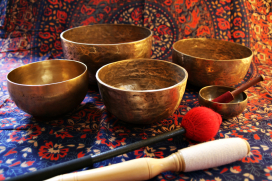 Bowls. Nandin’s creative process with these is interesting, as she describes here: “The tracks with the traditional meditative instruments were created by playing these instruments first, and then shaping the music to match them. Usually, these kinds of percussion instruments would be added later, but I wanted to use them and their particular qualities as the foundation for each piece. This meant that I started with the meditative character of those traditional instruments, and molded the music around them to reflect that. These instruments are also traditionally used to balance energy, so it was perfect to use them as the basis for the composition instead of adding them ornamentally later.”
Bowls. Nandin’s creative process with these is interesting, as she describes here: “The tracks with the traditional meditative instruments were created by playing these instruments first, and then shaping the music to match them. Usually, these kinds of percussion instruments would be added later, but I wanted to use them and their particular qualities as the foundation for each piece. This meant that I started with the meditative character of those traditional instruments, and molded the music around them to reflect that. These instruments are also traditionally used to balance energy, so it was perfect to use them as the basis for the composition instead of adding them ornamentally later.”
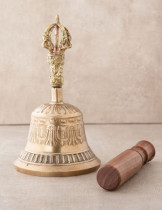 In my interview with Nandin, she provided a wealth of information about the instruments. I found her description of the Seven Metal Tibetan Bell used on track 4 quite fascinating: “The bell and Puja stick are two items traditionally used by many spiritual traditions throughout the East. The bell represents wisdom and the feminine aspect of the divine while the Puja stick represents the creative and forceful male energy. During ceremonies and rituals the bell is held in the left hand while the stick is in your right hand. As the sound of the bell resonates the bell and stick balance the negative with the positive to harmonize one’s life and surroundings. These items are also used for space clearing in Feng Shui.”
In my interview with Nandin, she provided a wealth of information about the instruments. I found her description of the Seven Metal Tibetan Bell used on track 4 quite fascinating: “The bell and Puja stick are two items traditionally used by many spiritual traditions throughout the East. The bell represents wisdom and the feminine aspect of the divine while the Puja stick represents the creative and forceful male energy. During ceremonies and rituals the bell is held in the left hand while the stick is in your right hand. As the sound of the bell resonates the bell and stick balance the negative with the positive to harmonize one’s life and surroundings. These items are also used for space clearing in Feng Shui.”
Track 7, “Meditation Arises,” uses Japanese Rin Gongs, which are found in Zen meditation temples in Japan. In 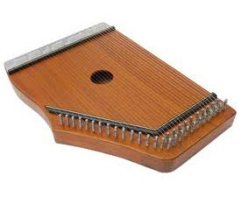 addition to these traditional instruments, each of the 8 songs on the album are built on a sound bed of ethereal synthesizers with string and/or choir sounds that create a very subtle background ambience for Nandin’s airy flute to drift peacefully over, accompanied on some tracks by the above mentioned healing instruments. The final track entitled “Joyous Return,” has a particularly Eastern ambiance with the drone of a tambura and the celestial sound of the swarmandal, or Indian harp. This piece evokes a sense of timelessness and makes for a wonderful conclusion to this tranquil listening experience.
addition to these traditional instruments, each of the 8 songs on the album are built on a sound bed of ethereal synthesizers with string and/or choir sounds that create a very subtle background ambience for Nandin’s airy flute to drift peacefully over, accompanied on some tracks by the above mentioned healing instruments. The final track entitled “Joyous Return,” has a particularly Eastern ambiance with the drone of a tambura and the celestial sound of the swarmandal, or Indian harp. This piece evokes a sense of timelessness and makes for a wonderful conclusion to this tranquil listening experience.
I had to make sure my feet were still on the ground when getting up after hearing this album with headphones. Reiki Meditations is quite transcendental and it’s hard to imagine a better soundtrack for meditation, yoga, massage, healing work, or just relaxing. Nandin’s flute playing is exquisite and I appreciate the intuitive and improvisational nature of it. Her go-with-the-flow approach is perfect for her and in our interview she shared that during the recording process she very rarely needs to do more than one or two takes.
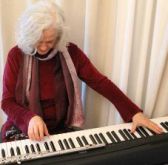 A perfect way to conclude this feature article is with a quote from Nandin in reply to my asking: “Why are you a musician, what does it mean to you?” In her words: “Music touches me deeply, and a life without it would definitely be emptier. There is something magic about what we can do through music. Shamans have used it since time immemorial, and almost every religion uses music to bring the listener back to their own being. J. S. Bach wrote his music ‘To the glory of God’ which always impressed me. I would like to think that I am also doing that in my own small way.”
A perfect way to conclude this feature article is with a quote from Nandin in reply to my asking: “Why are you a musician, what does it mean to you?” In her words: “Music touches me deeply, and a life without it would definitely be emptier. There is something magic about what we can do through music. Shamans have used it since time immemorial, and almost every religion uses music to bring the listener back to their own being. J. S. Bach wrote his music ‘To the glory of God’ which always impressed me. I would like to think that I am also doing that in my own small way.”

